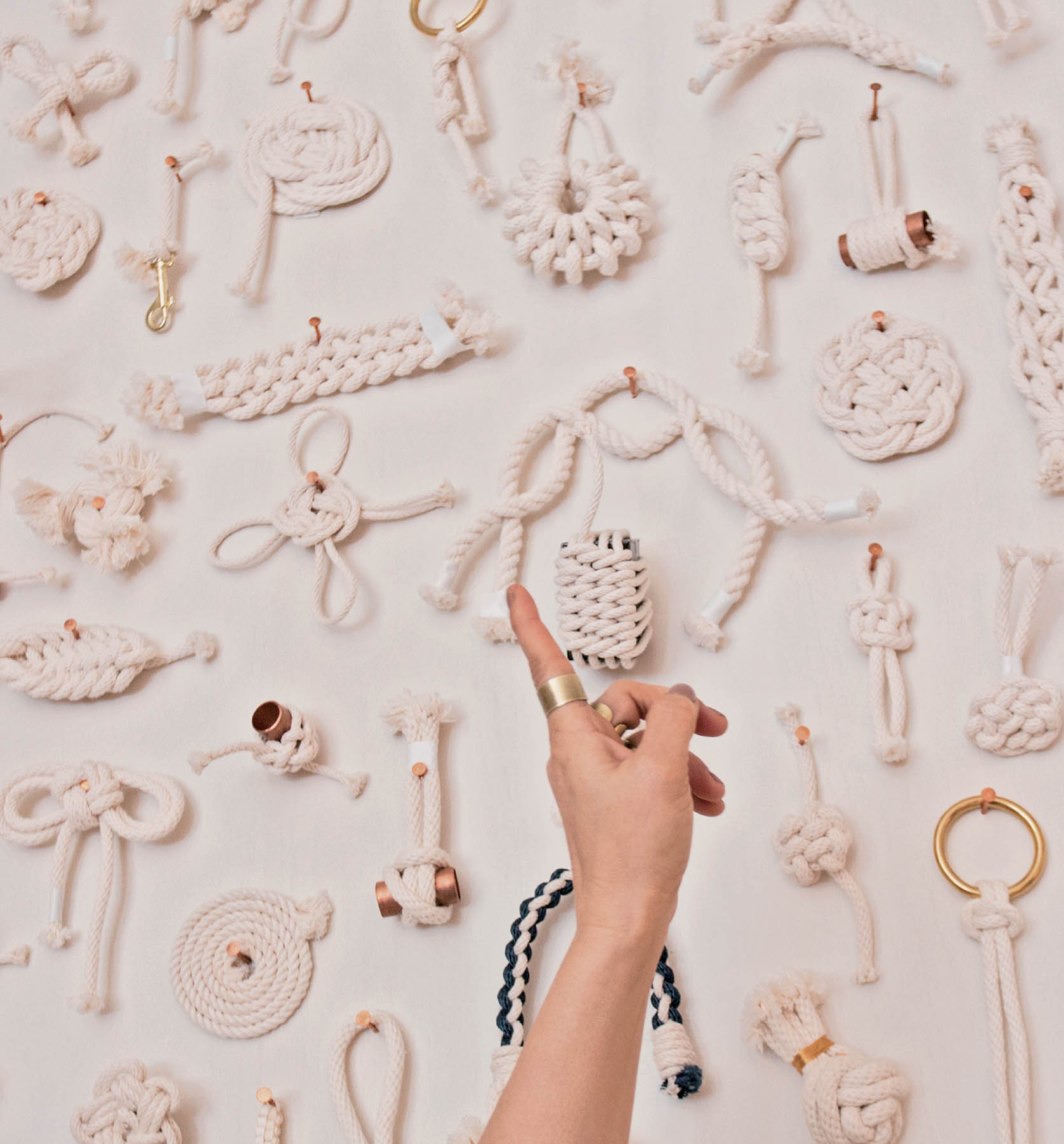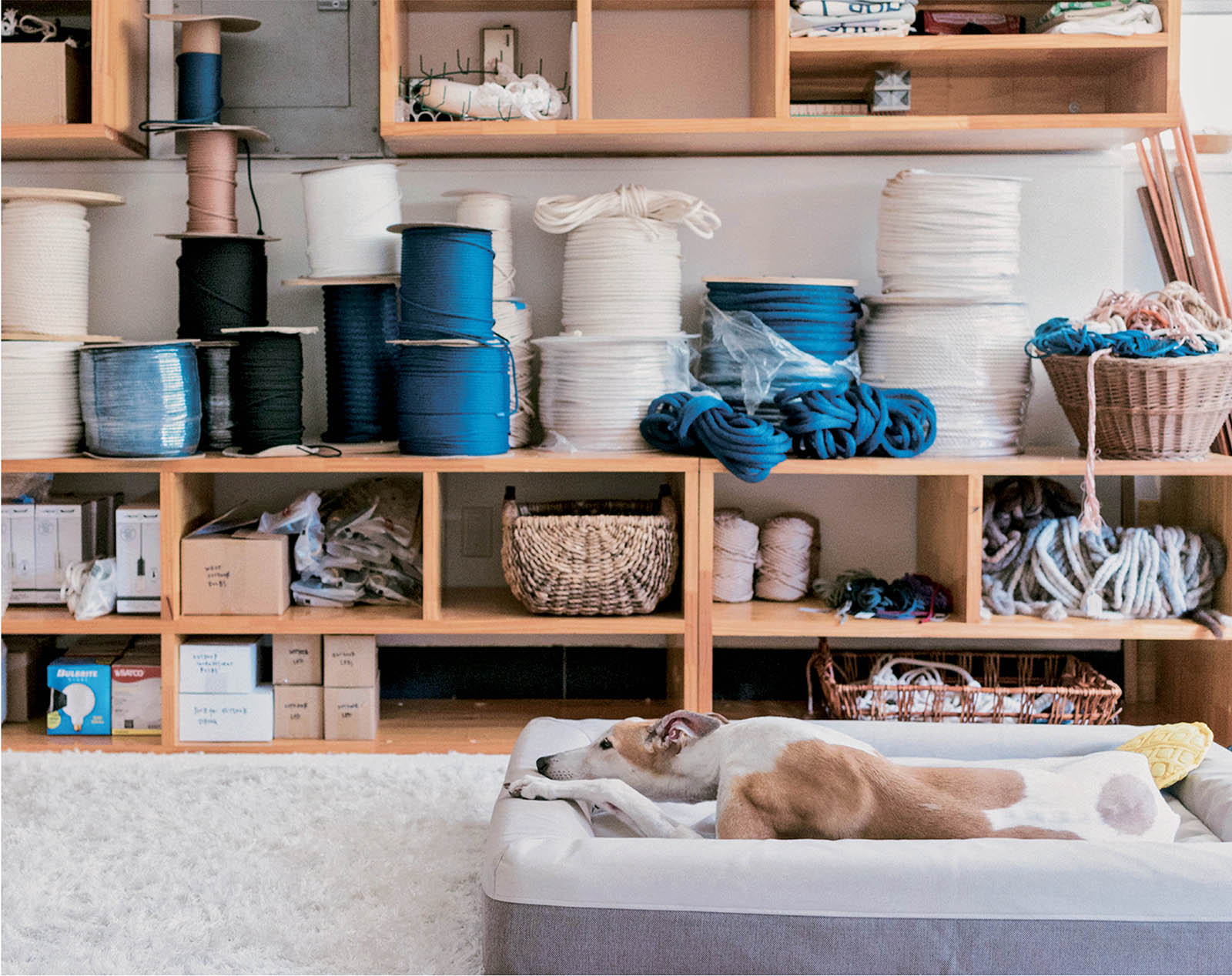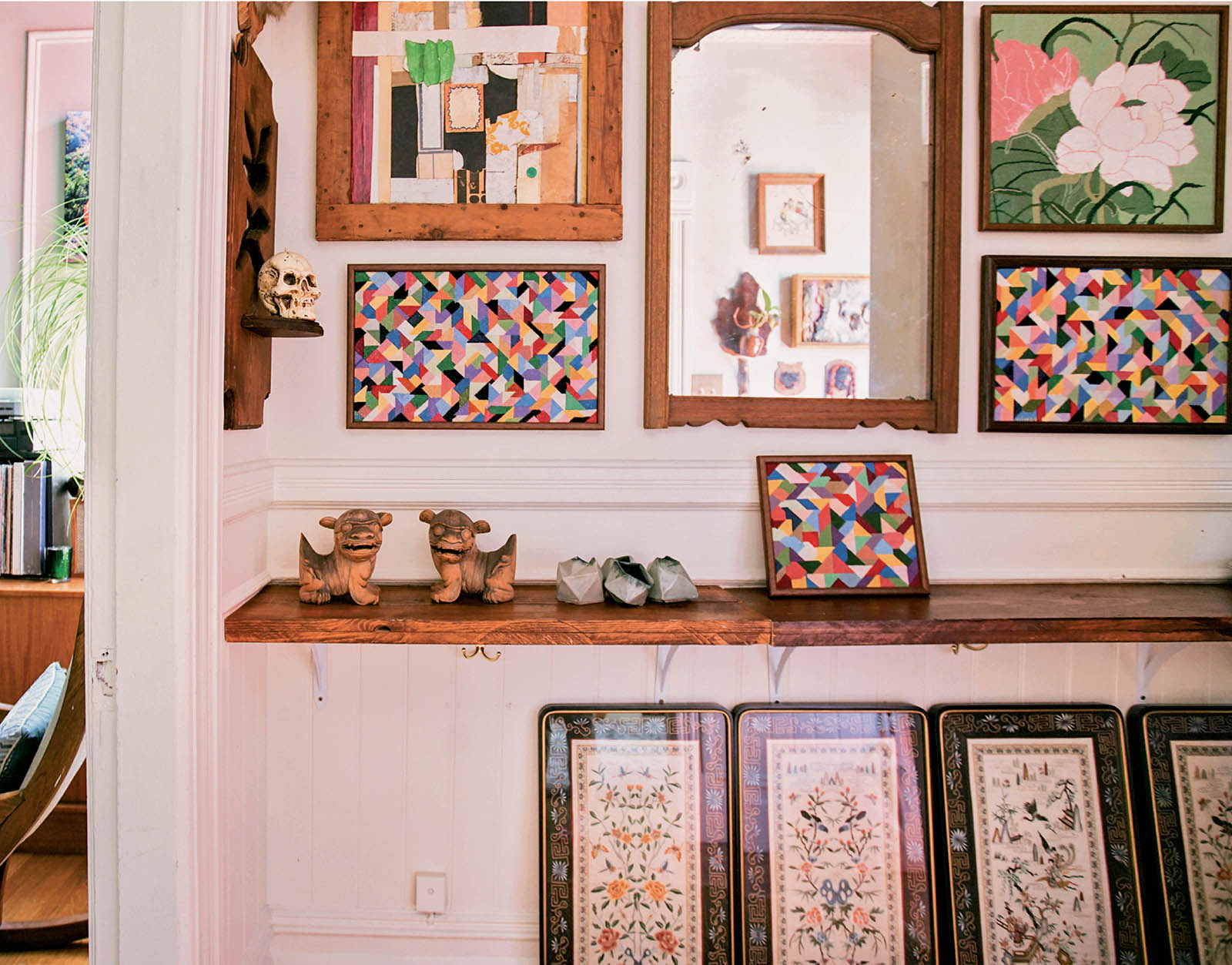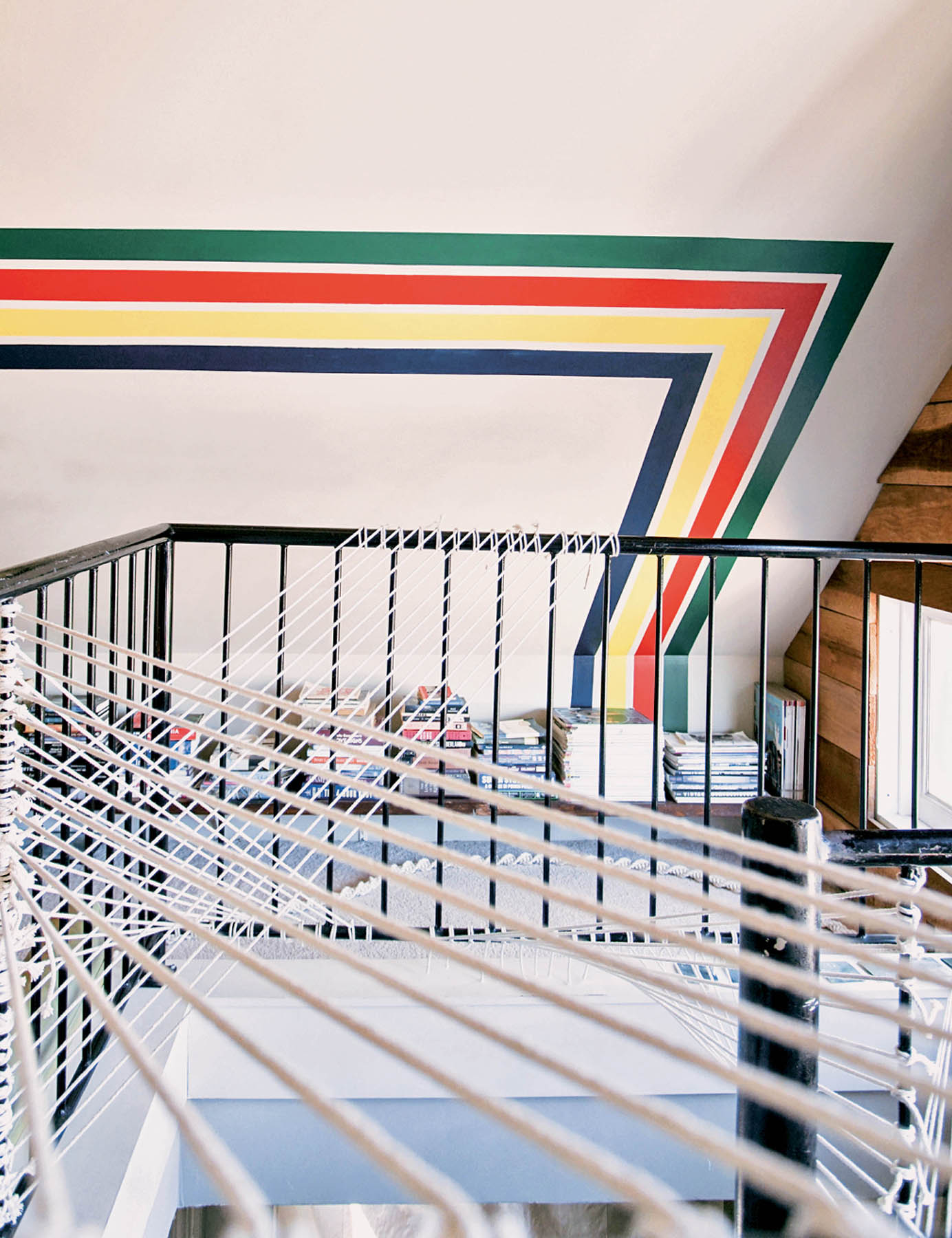Windy Chien
Learning a New Language

Windy in her studio, in front of her Year of Knots installation. The process of making it, one knot a day for the 366 days of 2016, taught her, she says, about the elemental building blocks of art: line, form, shape, space, texture, color, and value. In 2017, Facebook asked her to re-create the wall as a permanent installation at their campus in Menlo Park, California.
“When you first leave your job and are embarking on something new, anything seems possible. It is such a delicious place to be.”
For Windy Chien, 2016 was the Year of Knots. That January, she challenged herself to learn one new knot each day for 366 days (it was a leap year) and post her progress in real time on Instagram. Thirty-six months prior, she had made a dramatic change in her life: She had left her secure (and coveted!) job at Apple to forge a new path for herself, not knowing exactly what that path might be. She was employed by the global tech giant from 2005 to 2012, first as a product manager, producer, and curator for a fledgling iTunes, then as a managing editor for the App Store. Before that, she worked at and then owned San Francisco’s influential independent music shop Aquarius Records for fourteen years. But in December 2012, no longer fulfilled by curating and promoting the work of others, Windy decided to invest in herself and nurture her own creativity. Letting go of the security of her full-time position at Apple—not to mention the prestige and family approval that came with it—took some serious thought. But on that last day, after she had handed in her company-issued, state-of-the-art laptop and shared a champagne toast with colleagues, she drove from the company’s Cupertino headquarters to her home in San Francisco’s Mission District feeling elated. “When you first leave your job and are embarking on something new, anything seems possible,” she recalls. “It is such a delicious place to be.”
Windy had prepared for this moment with characteristic practicality, setting aside enough savings to cover her basic living expenses for at least a year and positioning herself to take on a few part-time consulting gigs with app developers. Her next move was to sign up for a series of classes—in anything that even slightly interested her, and with teachers whose work she admired. This led to explorations in stone carving, LED lighting, block printing, ceramics, weaving, interior design, and—the two media of the more than a dozen she tried that resonated—spoon carving and macramé. Her father, a career military officer who took the family to live at West Point, New York, and then on bases in Hawaii while Windy was growing up, was a weekend woodworker and carpenter. Her mother, who stayed at home to raise Windy and her younger brother, had taught her macramé in the 1970s. But Windy was still surprised that these two forms of creative expression, neither of which stuck with her as a child, were so appealing to her now that she was in her forties. Her interest in them, she surmises, must have been lying dormant, waiting.

Windy working a series of classic square knots, called Solomon’s bar.
Windy delved into woodworking first, taking bowl-turning and spoon-carving classes at the Crucible, a maker space in Oakland, in the summer of 2013. She didn’t care for the machinery or the flying wood chips inherent in turning, but she immediately loved everything about carving spoons, from the satisfaction of digging into and gliding through wood with a sharp spoon gauge or rasp and shaping it to her will, to the sanding and polishing of the wood to a velvety smooth finish, to the functionality of the finished product. Almost right away, she transformed a backyard storage space into a woodworking cottage, and within six months, she was selling her wares, including a unique cooking spoon with a squared-off corner that reaches into the curves and flat surface of a pan in a more efficient way than a conventional spoon.
While deep into spoon carving, Windy began exploring macramé. “Within five minutes, I remembered how much I loved it as a kid,” Windy recalls of the Saturday-morning refresher class she took with well-known instructor Emily Katz. As with spoon carving, she enjoyed the process, but she felt an even deeper kinship with the material. “Very quickly, all the expressive possibilities of the cord became apparent to me,” she says. “I loved how I could take what is essentially a line—one of the basic building blocks of art—and make it into something three-dimensional that has heft and weight and volume.” One of Windy’s early ideas was to create lighting for the bay window at the front of her Victorian house by combining macramé-covered wiring with utilitarian bulbs. When neighbors began knocking on her door to inquire about the cascading lighting system and friends asked her if she would make lights for them, Windy realized that she had created a viable retail product. She named her design the Helix Light since the macraméd square knots spiral like strands of DNA around the wires, and her work immediately caught the attention of consumers.

Cotton rope lashed with gold thread. Lashing is a technique for binding together two or more objects. Sailors lash with heavy twine or waxed floss. Windy elevates the technique by lashing with vintage 24-karat gold thread.
Windy saw macramé as a new language, each knot a new word, but she didn’t feel fluent in her usage of it yet. She needed to learn more knots to express her ideas and achieve a new aesthetic, distinct from traditional macramé, which relies on just a couple of knots repeated in different sequences, all tending to have a similar retro-bohemian look. And thus began the Year of Knots, an idea that came to her in a flash while she was sweeping her studio floor. Looking back now, she recounts, “When you’re a woodworker, sweeping happens at the end of a day or project and marks a transition between what just happened and what you’re going to do next,” which was exactly what was transpiring, literally and figuratively, on that January morning.
Windy’s main reference for this daily exercise was the massive, six-hundred-plus-page Ashley Book of Knots, a guide to more than thirty-nine hundred different knots first published in 1944 and still in print today. Each morning, she would flip it open, choose a knot to puzzle through, and make it out of white cotton rope. The simplest knots she chose required one strand, the most complex over a dozen. While the basic lanyard knot that she began with on day one took just a few minutes to learn, the star knot, a five-strand two-layered knot in the button family, took her well into lunchtime and required that she augment her book learning with a few YouTube videos (a multimedia approach that Windy succumbed to only a couple of times).

An assortment of Windy’s wooden spoons, including three with her signature squared-off corner.
From that disciplined practice came a high level of knot proficiency, as expected, as well as an unforeseen mind shift. During this morning routine, Windy found herself entering into a previously difficult-to-come-by state of creative flow. In an essay on her website, she remembers it like this: “The practice allowed me to quickly access flow, that elusive state of blissful productivity I’d heard about and longed to experience, where one is working with extreme focus, expanding and growing one’s abilities, free of cares and distractions. As I tied a new knot each day, I had the palpable sense I was connecting to a larger consciousness of creative energy.”
Windy had begun 2016 defining herself as a product designer and maker, but by year’s end, her mission and identity had evolved. She now self-identified as an artist. She saw the wall on which she had carefully hung each knot with a copper nail as an artwork in and of itself, marking a passage of time, a learning process, and the elevation of a quotidian material through her own intervention into a thought-provoking expression of her ideas. As she learned new knots, she developed a vocabulary for further exploration, often feeling inspired to experiment on a much larger scale. By posting her progress daily on Instagram, she had grown her following from a few hundred to over ten thousand, garnered press coverage from outlets as diverse as the New York Times, Wired, and Martha Stewart Living, and built up a clientele not only for the individual items—like the lighting and spoons on her website—but also for installations, many of which involved complex engineering challenges. There was a ninety-foot wraparound rope wall for the IBM headquarters in Cambridge, Massachusetts, and a thirty-foot-tall rope tree for a restaurant in Virginia. “I like making big things,” Windy stresses. “I want to take up space.”

Windy removed the doors to her backyard storage shed when she transformed it into her woodworking studio. “It’s empowering to have a space dedicated to you, where you get to determine what happens, a safe place where no one is going to judge you, because you’re the mistress of the domain.”
Windy was born with a certain audaciousness, always compelled to pursue what she found most interesting and culturally vital—whether that involved music, film (which she studied in college), the maker movement, art-making, the creative potential of technology, or even having her three-story Victorian house painted in multicolored ombré stripes. Her confidence allowed her to cut short her college education when she was one math class shy of finishing her degree (“That sort of certification never felt significant to me,” she explains) and to purchase the record store she started working at while in college and expand its reputation internationally by seizing on the communicative possibilities of the internet. It gave her the courage to apply for a job at Apple, one of the world’s most powerful companies, and to leave that company while still at the top of her game.
Interestingly, it was Windy’s yoga regimen that helped her recognize that it was time to leave Apple. Having practiced on and off since college, in 2012 she enrolled in a teacher training course in vinyasa, a modern yoga iteration in which poses flow together in energetic sequences. At the time, she thought she was seeking a disciplined exercise routine, but the benefits of the practice turned out to be deeper and subtler than she anticipated. She became more attuned to what her body and mind were trying to tell her. Through yoga, she says, “I was able to feel in my body and hear in my mind what my feelings were. I would observe what my day felt like and what my headspace was like and realized that I was living with all this negativity swimming around in my brain all the time.” The negativity came, in part, from the inevitable politics that impacted office life and also from an unfulfilled longing to join in the growing maker scene. “I kept seeing other people’s great work floating across my computer screen. I was in awe of the women who were making these beautiful objects,” she remembers.

Helix Lights hang above the worktable in Windy’s backyard studio.
By leaving Apple, Windy is quick to clarify, she wasn’t rejecting technology. While some makers see tech as antithetical to what they’re doing, Windy embraces it. She still preorders each new version of the iPhone and looks to video game design as a new artistic frontier. “How beautiful would games be if they were made for you and me?” she wonders. And as impressed as she remains by the hand makers who influenced her decision to leave her job at Apple, she is equally awed by many of the techies she has encountered. “It is inspiring to be around tech folks who have big eyes and big ears and are soaking it all in,” she says.
At Apple, she recalls, everything had to be perfect, and she absorbed the Steve Jobs ethos, then in its heyday: Every detail must be thought through; the inside and outside and the back and front must be equally beautiful; and all inessentials must be stripped away to find the essence. When Jobs died, the company held a private ceremony for employees at which they distributed a folio of his now-famous 2005 commencement address at Stanford University, which to this day Windy keeps on a table in her bathroom. Her favorite passage reads, “Remembering that I’ll be dead soon is the most important tool I’ve ever encountered to help me make the big choices in life. Because almost everything—all external expectations, all pride, all fear of embarrassment or failure—these things just fall away in the face of death, leaving only what is truly important. Remembering that you are going to die is the best way I know to avoid the trap of thinking you have something to lose. You are already naked. There is no reason not to follow your heart.”

Windy showed me how to make her Ringbolt Necklace, which requires working the ringbolt hitch around a wooden hoop. After designing these necklaces, one of which you can see her wearing, Windy started playing with the idea of enlarging her scale; this led to her Diamond Ring series, a group of large (about five-foot-wide and -tall) works composed of sixteen plywood rings assembled in a diamond pattern and adorned with a curvilinear pathway of knotted rope.
Keeping Jobs’s counsel in mind, Windy now embraces her life and follows her heart by staying present in and enjoying each and every possible moment. “I pretty much love every minute of what I am doing,” she says. “I love cutting the rope, measuring, talking to the client, making the work, finishing it, and taking the photos and sharing them.”
What lies ahead for Windy? There will be more exploration, more collaborations for interior and exterior spaces, and the publication of a book, called The Year of Knots. And then, the unknown. “Craft evolves one step at a time. You don’t plan it out twenty-five steps ahead. You do what the material is suggesting to you. Maybe this is how we should look at our lives. Here is what I have now. What makes sense and is going to bring me some joy? Next thing, then next thing. And four years later, you’re an artist.”

Windy is pointing to a doughnut-shaped knot she named the Cruller. “This knot is significant,” she says, “because it represents the growing confidence I experienced during the Year of Knots.” As her understanding of knots’ structure and mechanics evolved, her confidence grew and she felt able to invent a handful of her own knots, like this one, which is derived from the Heaving Line knot.

Windy’s beloved greyhound, Shelley Duvall, is a regular in the studio. Here she is napping in front of an assortment of Windy’s supplies. Windy began this art odyssey with ordinary cotton rope. Since then she has explored many other materials, including polypropylene sailing rope, felted wool rope, and Ethernet cable. “If you think of my work as being an exploration of the line, the material could be anything,” she says.

Windy’s Victorian house in the Mission District of San Francisco. She had the front painted in stripes ranging from yellow through orange to red and the back painted in stripes ranging from yellow through green to blue, a nod to the late 1960s–early 1970s graphic style to which she is drawn.

Windy made her first Helix Light for the bay window at the front of her home. Although the creative part was in the designing, she still finds making the lights satisfying. “I put on a podcast or audiobook, and it’s heaven,” she says.

Windy is named after her grandmother, who was, Windy recalls, “an amazing artist.” Her needlepoints hang in the entryway of Windy’s home.

A prototype for Twisted Planes installed in the stairwell leading up to Windy’s bedroom.

Windy created this installation, called Twisted Planes, for the San Francisco headquarters of AngelList, a website for connecting start-ups. “I loved the idea of making a whole environment,” Windy remembers. She used the rafters, what she calls the “bones of the space,” as part of the installation. To work out the design, first she drew on photos of the space. Next she created a prototype and installed it in the stairwell leading up to her attic bedroom at home. “It is made of straight lines and tension, but you see different curves depending the axis you view it from,” she comments. “It’s nice to have fiber above our heads, in spaces that are usually neglected and where we’re used to seeing metal.”

Windy made this installation, called Rope Frameworks with Canopy, out of cotton, steel, and leather for a venture capital firm in San Francisco.














